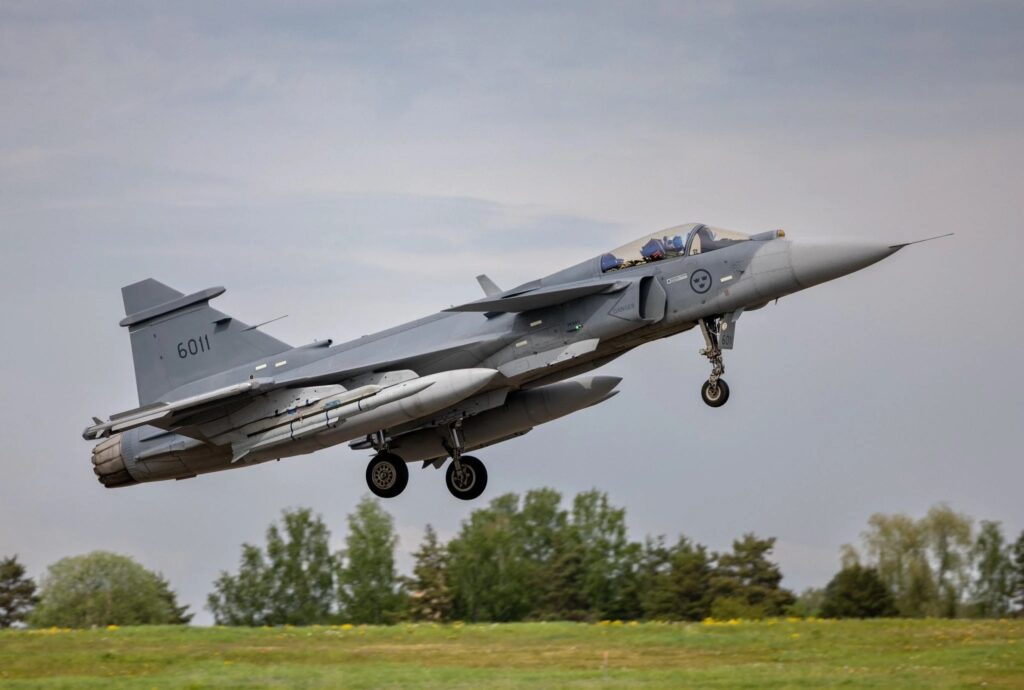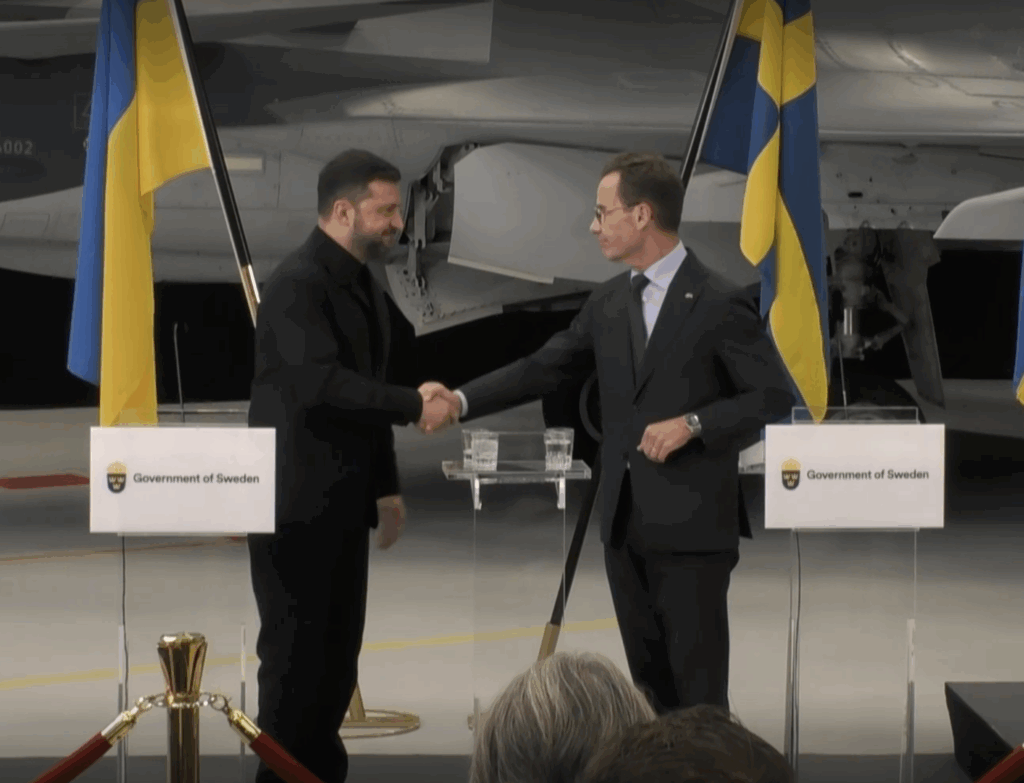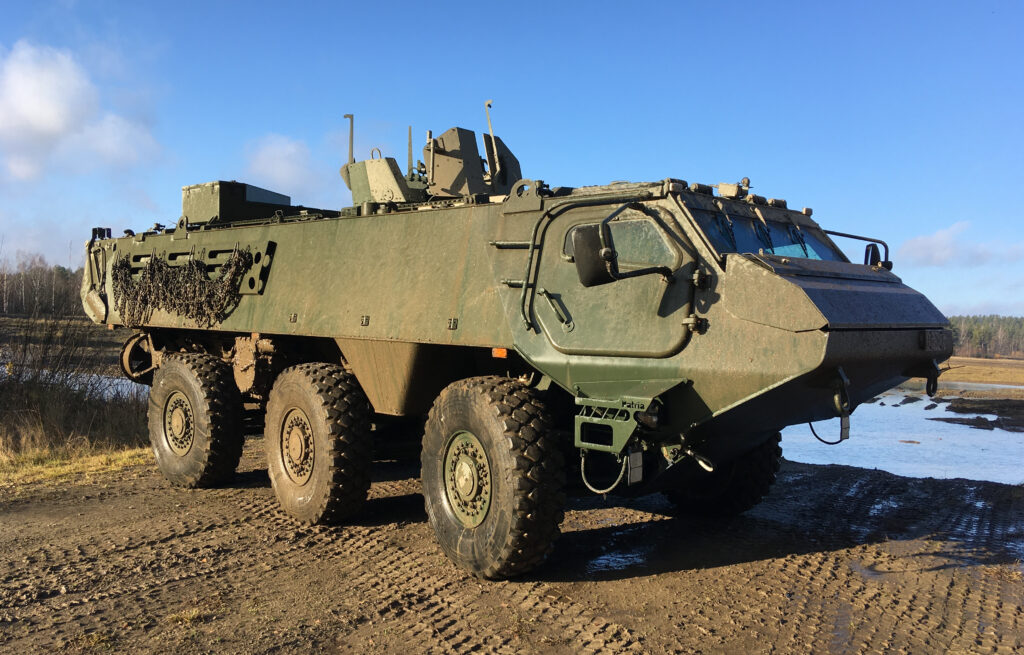Sweden has taken a historic step towards becoming a major arms supplier to Ukraine, signing a letter of intent (LOI) covering the export of up to 150 Saab JAS-39 Gripen E fighters. President Volodymyr Zelenskyy and Prime Minister Ulf Kristersson announced the plan at Saab’s Linköping headquarters.
The deal, the largest defence-export framework in Swedish history, is not a gift but a negotiated commercial and strategic partnership designed to strengthen Ukraine’s long-term air-combat capacity.
The announcement caps years of debate in Stockholm over how far Sweden should go in arming Ukraine. A government notice trailed the event as “a major defence-export announcement.” Video from the joint press conference shows Kristersson and Zelenskyy watching the fly-past before declaring that the Gripen programme “binds our two nations in shared defence of freedom.”
A European Jet for a European War

For Ukraine, the Gripen represents something both practical and political. The aircraft was built for European conditions—short, icy runways; dispersed basing; and rapid turnaround in contested airspace. Analysts have long noted that the Swedish fighter’s road-based doctrine, robust logistics and modular electronics suit the demands of a nation under constant missile and drone attack far better than heavier, maintenance-hungry Western types.
The Gripen E is already in operational service with Sweden and Brazil, and has been selected or evaluated by Czechia, Hungary, South Africa and Thailand. In each case, the aircraft’s appeal lay in its combination of NATO-standard weapons, relatively low operating cost, and political autonomy from Washington’s export-licensing system. Brazil’s contract included technology transfer and local assembly—an arrangement Ukraine is now expected to mirror in its own industrial participation plan.
Offering Political Insurance
Kyiv’s first tranche of Western jets will be F-16s, but the Gripen offers political insurance. Unlike US-sourced aircraft, it is not hostage to the shifting winds of Capitol Hill. Swedish export control remains inside the EU but outside NATO’s US-centric ecosystem, providing Ukraine with a measure of independence.
Technically, the Gripen’s PS-05/A Mk4 radar, Meteor BVRAAM integration, and IRIS-T short-range missiles give it parity with top-tier Western fighters at a fraction of the lifecycle cost. It is cheaper to fly—roughly one-third the hourly operating cost of an F-35—and far simpler to maintain in austere field conditions. Its Volvo RM12/GE F414 engine is proven and widely supported.
That combination of affordability, survivability and political flexibility explains the choice. For a country fighting for existence while counting every shell, the Gripen looks like the pragmatic European answer to a European war.
Deliveries From 2026
The LOI envisions up to 150 aircraft, phased deliveries from 2026 onwards, and a multi-layered package of training, sustainment, weapons integration and potential co-production inside Ukraine. Negotiations now turn to financing—expected to involve Nordic, EU and trans-Atlantic backers—and to workforce scaling for maintenance and pilot conversion.
For Saab, the potential order would double its fighter backlog and inject momentum into the Nordic aerospace supply chain. Sub-contracts for radar, engines and EW systems will spread across Sweden, Finland, the UK and parts of Central Europe. The deal would also reinforce Saab’s position as the only credible European alternative to US and French fighter oligopolies.
Industrial and Strategic
From industrial and strategic perspectives, there are at least three clear dimensions to this fighter agreement between Sweden and Ukraine:
- Industrial risk and reward. This would be a once-in-a-generation expansion for Saab, forcing an increase in production capacity and a surge in pilot training throughput. Western financiers and insurers will demand clarity on battlefield risk and delivery security.
- Operational logic. The Gripen’s distributed-operations model fits Ukraine’s tactics—using rural roads, hardened shelters and mobile ground crews. Its ability to arm and refuel within ten minutes, even from improvised bases, turns survivability into doctrine. The bottlenecks will be munitions and trained personnel, not hardware.
- Geopolitical message. Sweden has shifted from cautious donor to strategic exporter, sending a blunt signal that European industry will arm Europe when Washington hesitates. Moscow will almost certainly flood the information space with talk of “direct Swedish involvement.” The government insists this remains a commercial export, not an active deployment.
The F-16/Gripen mix gives Ukraine redundancy and diplomatic agility: US hardware for NATO interoperability, Swedish hardware for European self-reliance. It will, however, complicate logistics and sustainment. Running two fighter ecosystems demands twice the spare parts, twice the training syllabi, and iron discipline in planning.
Future Mixed Western Fleet
If the framework solidifies into a contract, first Ukrainian Gripen pilots could begin conversion training at F 7 Wing Såtenäs next year, with early aircraft deliveries by 2026-27. Ukraine’s air force would then field a mixed Western fleet—F-16s for strike and SEAD, Gripens for air defence and dispersed interception.
For Sweden, this is both a commercial coup and a test of political will. The country is betting that its flagship fighter can underpin Europe’s defence industrial autonomy while surviving intense Russian and US scrutiny. For Ukraine, it is the first credible path to a fully European air arm.
Read More:
- Swedish Government: Prime Minister receives Ukrainian President Zelenskyy
- Reuters: Sweden and Ukraine eye export deal for up to 150 Gripen fighter jets
- Flight Global: Ukrainian air force could acquire up to 150 Saab Gripen E fighters from 2026 via pact with Sweden
- Aviation Week: Ukraine Selects Gripen E For Rebuilt Fighter Fleet
- Bloomberg: Sweden Agrees Plan to Sell as Many as 150 Saab Jets to Ukraine
- AP News: Zelenskyy and Kristersson watch Swedish fighter jets perform as countries agree deal on Gripen planes
- YouTube: Zelenskiy & Swedish PM Kristersson Sign Landmark Gripen Fighter Jet Deal in Sweden
- Breaking Defense: Ukraine moves to buy scores of Saab Gripen fighters from Sweden
- European Security & Defence: Sweden makes key move toward supplying Ukraine with Gripen fighters
- AP News: Sweden to donate $1.23 billion in military aid to Ukraine (2024)



